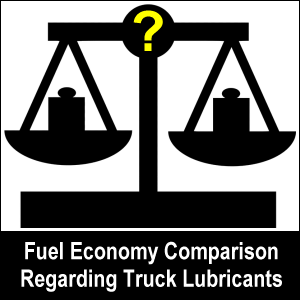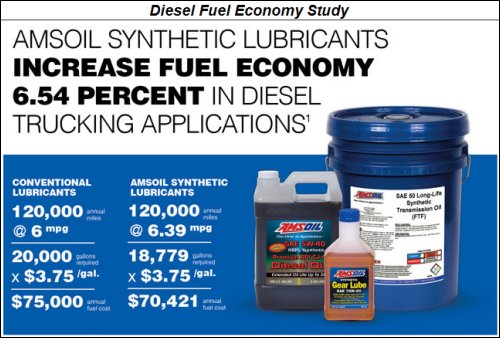A website shows a fuel economy comparison between large trucks, one of which ran a conventional truck lubricant, the other of which ran a synthetic lubricant.(1)
 The calculation — as it is listed — is correct.
The calculation — as it is listed — is correct.
Fuel economy is calculated by dividing the distance traveled (ending mileage minus beginning mileage) by the number of gallons of fuel used to get “miles per gallon” or “mpg.”
True, based on miles per gallon and the cost per gallon for fuel, one can figure one’s total fuel costs.
But one will not get an accurate picture of one’s total costs of operating a truck when the cost of lubricants is missing from the calculation.
We will explain.
Here is a reduced-size and bordered — but otherwise unaltered – image from the website, showing the fuel economy comparison:

By stating that the synthetic truck lubricant being advertised raises the miles per gallon – or lowers the number of gallons of diesel used over the distance covered — one could infer that the lubricant helps truckers save money on their operations.
This is the point we are making: the cost of lubricants is never entered into the calculation because this kind of calculation isn’t meant to.
Let’s do a bit of math using the cost of lubricants we found online.
(Note: Your sources and costs may be different, but these are just for the sake of comparison.)
As a baseline, we’re going to compare the cost of two different kinds of 15W40 motor oil, available in 1 gallon quantities, as of April 27, 2012.

It must be noted that the calculations of the truck lubricant costs alone do not tell the whole story either, because using a synthetic oil may have this effect on maintenance:
- increase in drain interval and
- potential reduced wear and tear on the engine.
The referenced website said that the fuel economy comparison was conducted over 120,000 miles.
If a truck running conventional oil has its oil changed every 30,000 miles, then that means that there will be 4 servicings over that period.
($142.67 * 4 = $570.68)
If the synthetic oil could possibly be used twice as long for half as many servicings (a drain interval of 60,000 miles), that reduces the overall cost versus 4 servicings.
($396.55 * 2 = $793.10)
To answer our question about fuel economy comparison, does the savings in fuel from using the synthetic oil include the truck lubricant cost?
No, because it isn’t meant to.
But if we add in the truck lubricant cost — with all else being equal in the trucks’ operations — the cost difference shrinks a bit.
![]() Money saving tip: Save yourself the aggravation of missing part of the cost of your truck operations when you make calculations of this kind.
Money saving tip: Save yourself the aggravation of missing part of the cost of your truck operations when you make calculations of this kind.
A fuel economy comparison is one thing.
But you need to keep in mind all of the factors that affect your truck operations, not just the number of gallons of fuel that you use.
This includes not only lubricants but also any changes to your truck’s aerodynamics such as side skirts, wheel covers, and vortex generators, as well as fuel additives and fuel filters.
Keep up with which changes produce which returns on investment.
For best testing, change only one thing at a time and measure, measure, measure.
If you are comparing the effect of lubricants on diesel usage as part of your overall truck operations, do not forget to include the cost of lubricants in your calculation!
This could also include the reduced number of servicings and longer distances or times between an overhead.
Shop around to find the truck lubricant that is right for your truck, including the type (conventional or synthetic) and grade.
Explore the possibility of bulk pricing (possibly through your trucking company, a network or national account).
Buying oil by the gallon (or smaller amounts) may be the most expensive way to buy it, especially if it is purchased in a truck stop travel store.
Return from Fuel Economy Comparison: Savings Include Truck Lubricant Cost? to our Truck Operations page or our Truck Drivers Money Saving Tips home page.
References:
1.
amsoil.com/dieselfueleconomystudy.aspx?referrer=RR-Remarketing&gclid=CKaRq7jy1K8CFQpj7AodbH2zdQ (no longer online)
2.
http://www.walmart.com/ip/Rotella-T-15W40-Motor-Oil-1-Gal/14958327?
ci_src=14110944&ci_sku=14958327&sourceid=1500000000000003260530
3.
amsoil.com/a/Synthetic-Diesel-Motor-Oil-Engine-Oil (no longer online)







